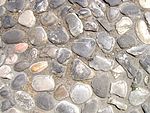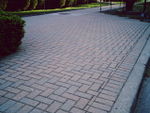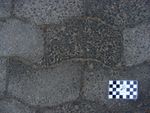Tag:surface=cobblestone
| Description |
|---|
| Generic value for cobblestone, used for both sett and true cobblestone |
| Group: properties |
| Used on these elements |
| Useful combination |
|
| Status: de facto |
| Tools for this tag |
|
Generic value for cobblestone in the colloquial sense. It's better to use a more precise value such as sett or unhewn_cobblestone
Main problem with surface=cobblestone is conflict between typical use of that term both for sett (stones cut/broken but not machined to be flat) and for true cobblestone. It is used for both.
Distinguishing sett and true cobblestone
Distinguishing this surfaces is useful, as sett is far more passably for bicycles, trollers, wheelchairs, old people etc etc. This distinction my be also useful for other purposes. This makes surface=cobblestone quite problematic.
See also
| Key | Value | Comment | Photo |
|---|---|---|---|
| surface | sett | Sett paving, formed from natural stones cut usually to a regular shape. | 
|
| surface | unhewn_cobblestone | Raw cobblestone of natural, uncut, rounded stones. Unlike pebblestone firmly connected to the ground. | 
|
| surface | paving_stones | Paving stones have relatively smooth surface. The surface is paved with artificial blocks (block pavers, bricks) or natural stones (flagstones), with a flat top. The gaps between individual paving stones are very narrow, either because the stones have a perfectly regular shape (rectangular, or any surface-filling shape) or because they have been carefully selected, fitted and placed in order to form an even, closed surface. |  
|
Tag usage history

As sett surface is often referred to as "cobblestone" these two distinct surfaces were mixed. Note that surface=cobblestone has been used since 2008 while surface=sett first appeared in 2013[1], which means that any sett surface mapped before 2013 was tagged in a way not allowing it to be distinguished from actual cobblestone, an issue that definitely also continued after 2013.
To resolve this problem in 2018 the surface=unhewn_cobblestone tag was created, which means surface=cobblestone can be treated as "either sett or proper cobblestone" and retagged to a more clear value during a survey.
surface=cobblestone decrease since that time is driven in large part by StreetComplete treating it as surface that needs resurvey (and asking user to specify it and giving surface=unhewn_cobblestone and surface=sett among options).
